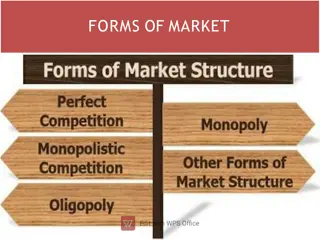Understanding Entry and Exit Dynamics in Industries
Explore the fascinating world of entry and exit in industries, from the facts and barriers to Bain's typology of entry conditions and structural entry barriers. Learn about entry deterring strategies such as limit pricing, predatory pricing, and strategic bundling, and how they impact the market landscape. Discover the nuances of how new firms enter, grow, and exit in different industries, shedding light on the intricate dynamics at play.
Download Presentation

Please find below an Image/Link to download the presentation.
The content on the website is provided AS IS for your information and personal use only. It may not be sold, licensed, or shared on other websites without obtaining consent from the author. Download presentation by click this link. If you encounter any issues during the download, it is possible that the publisher has removed the file from their server.
E N D
Presentation Transcript
ENTRY AND EXIT CLASS 5
FACTS ABOUT ENTRY AND EXIT Imagine and industry that has a 100 firms with a combined annual sale of $100 million. (Research study analyzing 250,000 US manufacturing firms since 1982) 1. Entry and Exit will be pervasive by 2017 between 30 and 40 new firms will enter with a combined annual sale of $12-20 million. At the same time a similar number of firms will exit 2. Entrants and Exiters will be smaller than established firms. 3. Most entrants don t survive 10 years, but those that do grow very fast. 4. Entry and Exit vary by industry. 1. Apparel, Lumber and Leather have high exit rates and entry rates 2. Tobacco and Paper have very low entry and exit rates.
BARRIERS TO ENTRY Structural Incumbent has a natural cost or marketing advantage, or when they enjoy favourable regulations Strategic Entry Barriers Incumbents take aggressive actions to deter entry. Entry barriers either raise sunk entry costs or reduce profitability. Other entry barriers 1. Sunk costs incumbent has incurred them competitor has not 2. Production barriers economies of scale or scope 3. Reputation long standing relationships with suppliers and customers. 4. Switching Costs Can firms prevent imitation. 5. Holding excess supply flooding the market causing large price reductions.
BAINS TYPOLOGY OF ENTRY CONDITIONS Joseph Bain argued that markets may be characterized according to whether entry barriers are structural or strategic and whether incumbents can profit from using entry-deterring strategies. Blockaded Entry Entry is blockaded if structural barriers are so high that the incumbent need not do anything to deter entry. Accommodated Entry Entry is accommodated if structural entry barriers are low. Either entry deterring strategies will be ineffective or the cost of the incumbent trying to deter entry might be too high. Since entry is attractive incumbents should not waste resources trying to deter it. Deterred Entry Entry is deterred if the incumbent an keep the entrant out by employing an entry deterring strategy and if employing the entry deterring strategy it boosts the incumbents profits. (Predatory acts)
STRUCTURAL ENTRY BARRIERS Control of Essential Resources Economies of Scale and Scope Marketing Advantages Umbrella Branding Advertising costs drop Suppliers are willing to supply at cost Super markets are willing to give opportunities for well established brands
ENTRY DETERRING STRATEGIES Limit pricing Incumbent firms charges a lower price to discourge new firms from entering. Predatory pricing occurs when a large incumbent sets a low price to drive smaller rivals from the market. Any losses it incurs from driving competitors from the market can be made up by future monopoly profits. Strategic bundling Bundling occurs when a combination of goods and services are sold a price that is less than what it would cost to buy the same items separately. McDonald s Happy Meals Vacation packages
JUDO ECONOMICS Small firms can use the incumbent s size to their advantage. (*) When incumbent s slash prices they lose more money than a new entrant (*) Incumbent s might hamstrung by their own sunk costs. Example block buster video.
HOMEWORK 1. Send me an email with your group name and list of all students to naveen.darley@gmail.com 2. Find out how to register a company, and the costs, and think of a name for your company. Company name will be your group name. 3. Come up with a logo for your company? Explain why a logo is important. 4. Figure out what industry you want to compete in. Explain in detail why.























